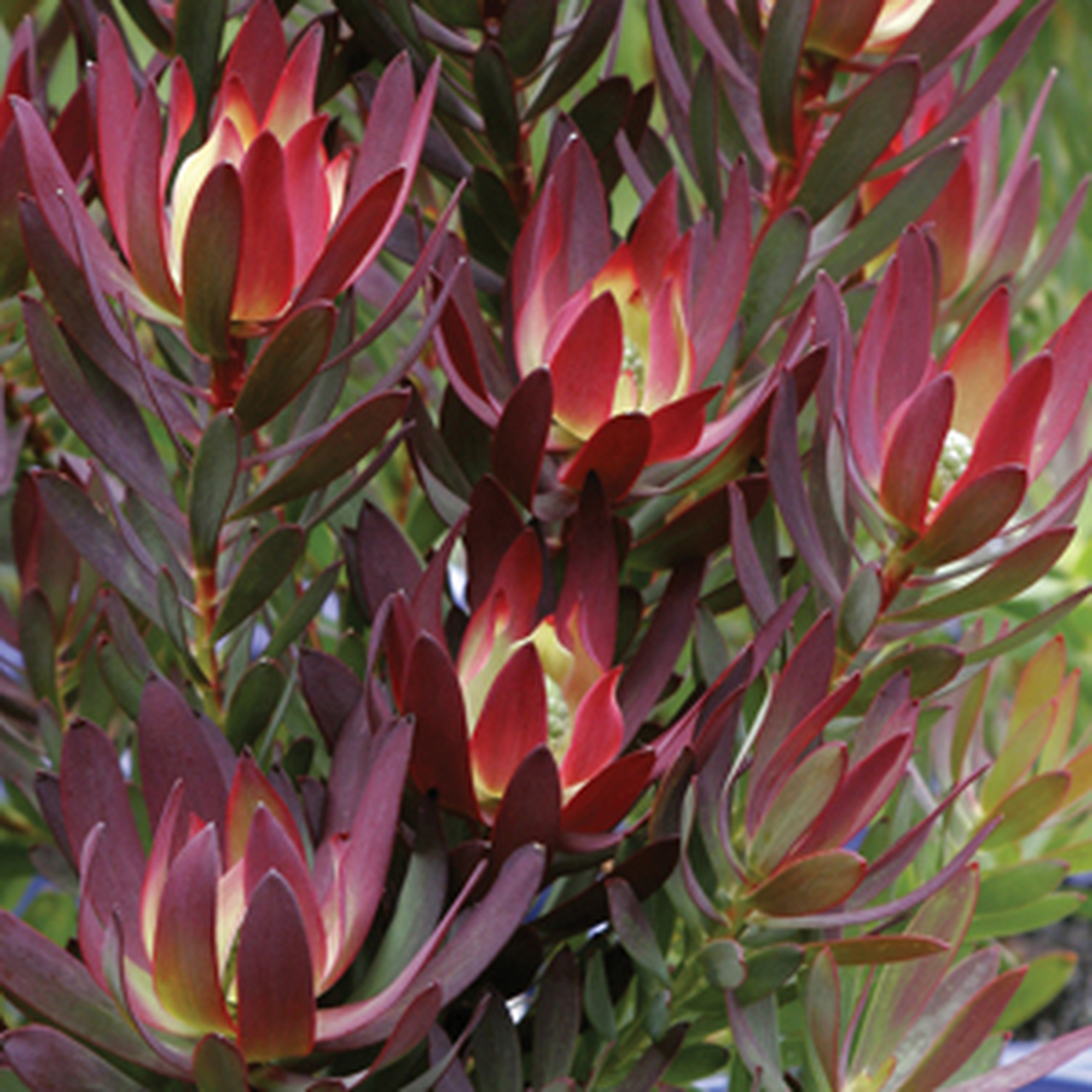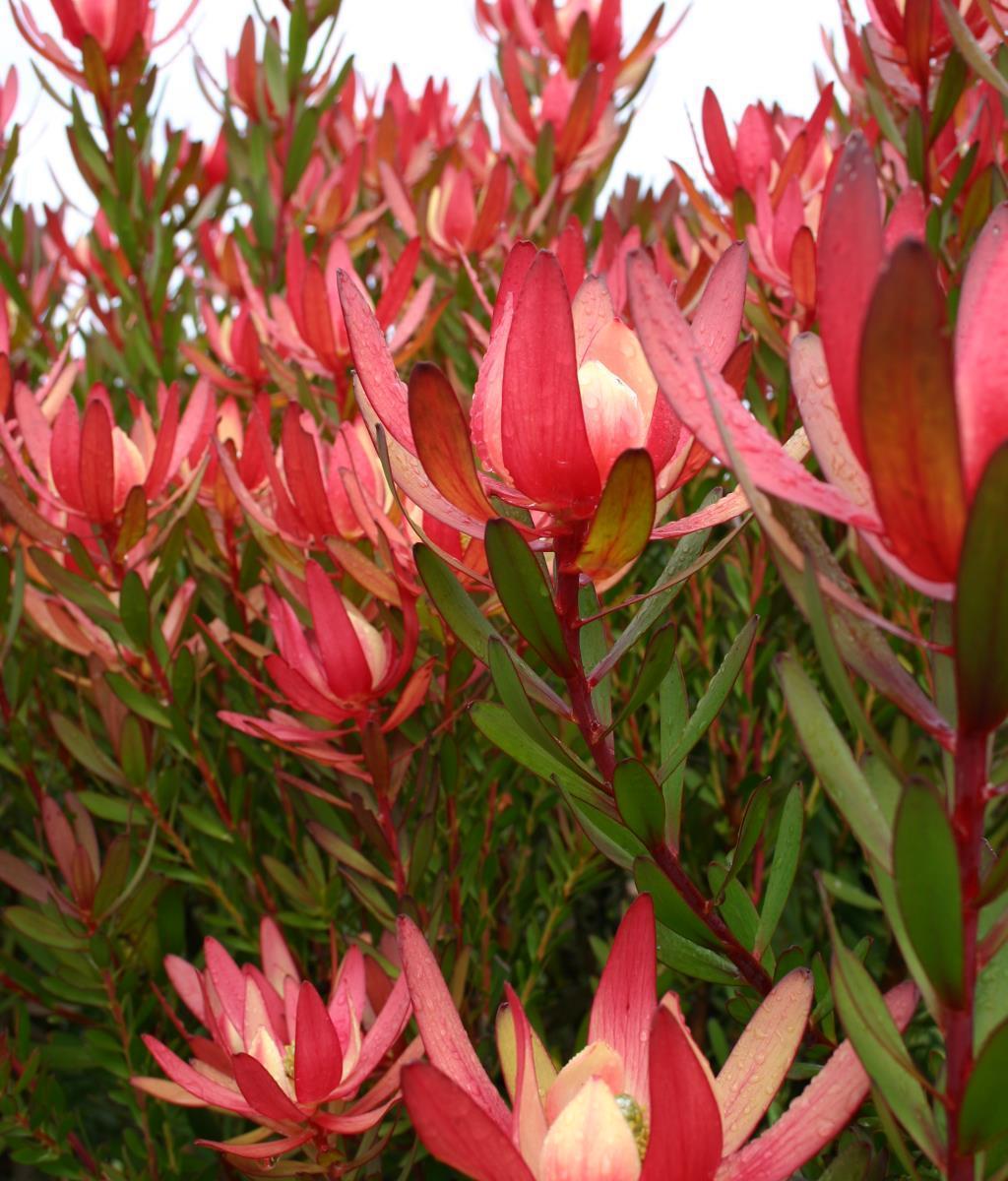Hailing from South Africa, leucadendron encompasses a large group of plants ranging from 4-foot-tall evergreen shrubs to 30-foot-tall trees. They’re hardy in Zones 9-11 and have colorful flowers and attractive foliage. Laucadendron plants, also called conebushes, are low-maintenance plants once they are established.
:strip_icc():format(webp)/101736395.jpg.rendition.largest-9d4aa38380bb4a3a988eaab7de01a4c9.jpg)
Leucadendron Overview
Genus NameLeucadendronCommon NameLeucadendronPlant TypeShrubLightSunHeight3 to 30 feetWidth5 to 10 feetFlower ColorPink, Purple, Red, White, YellowSeason FeaturesSpring Bloom, Winter BloomSpecial FeaturesCut FlowersZones10, 11, 9PropagationSeed, Stem CuttingsProblem SolversDrought Tolerant, Good For Privacy
Where to Plant Leucadendron
Leucadendrons like humidity and good air circulation, so plant them in the open and avoid crowding plants together. They don’t tolerate wet feet; in wet areas, they are best planted on a slope or mound or in a raised bed.
Select a spot with full sun and well-draining acidic soil. Leucadendron can only be grown outdoors in hardiness zones 9-11, but they can be planted indoors or in containers that can be moved indoors in cold weather in other areas. They work well in drought-prone spots and are stunning as specimen plants. Smaller varieties are attractive in a border and provide long-lasting flowers and foliage for cut-flower arrangements.

How and When to Plant Leucadendron
Plant leucadendron in autumn or after the last frost in spring to give the plant time to establish before summer. Dig a hole twice as wide and deep as the nursery container in a sunny location. Add compost to the soil to improve drainage. Adjust the pH if needed to reach 6.0 or lower. Backfill the hole halfway with the amended soil. Remove the leucadendron from the nursery container, being careful not to damage the roots. Set it in the hole so it is at the same height as it was in the container. Continue to backfill the hole, pressing down with your hands to remove air pockets. Water the plant.
Leucadendron Care Tips
Leucadendron needs the right soil and atmosphere to grow, but it is easy for care for once established.
Light
Leucadendrons grow best in full sun. The plants will grow in partial shade, but the blooms aren’t as colorful without full sun.
Soil and Water
This plant needs fast-draining, acidic soil. (It suffers in heavy clay or high pH conditions.) To be safe, test your soil’s pH with an inexpensive soil test kit. A pH of 6 or lower is best, but higher pH soils can be acidified with peat moss and sulfur.
To avoid foliar diseases, water plants at the base. If overhead watering is the only option, irrigate earlier in the day so foliage can dry before nightfall. Leucadendrons are drought-tolerant once the roots have established themselves, but they benefit from regular, deep watering. Allow the soil to dry somewhat between waterings. Mulch once a year to control weeds and conserve moisture.
Temperature and Humidity
Leucadendron needs warm temperatures. It usually doesn’t survive cold or frost. Some varieties can survive a temperature in the 20s for a short time, but substantial damage to the plant is likely. It prefers a warm, humid environment and good air circulation.
Fertilizer
This shrub is not a heavy feeder and usually doesn’t require any fertilizer. If you do fertilize, use a product without phosphorous such as a 15-0-15 NPK ratio. For the amount to use, consult the product label directions.

Pruning
In the spring, deadhead the spent blooms as they occur. After flowering is completed for the season, cut back the green stems so there are four sets of leaves remaining. Don’t cut back as far as the woody stems, though, or no new growth will appear for the following season.
When pruning a leucadendron grown in a container or as a houseplant, wait until it is finished blooming and remove spent blooms and damaged or crowded foliage. Don’t remove healthy stems that haven’t bloomed. Prune the entire plant by up to one-third.

Potting and Repotting Leucadendron
Plant leucadendron in a container with good drainage. Fill it with a loose, well-draining potting mix formulated specifically for acid-loving plants. Put it in a sunny spot and fertilize it once a year in early spring with a low-phosphorous product. As a houseplant, it requires warm temperatures and a bright sunny window location to thrive indoors. When it is grown as an outdoor container plant, it must be overwintered indoors in all but the warmest environments. These plants can grow quite large, so look for one of the smaller varieties that top out at 5 feet or less for a manageable-size container plant. Repot once a year in spring.
Pests and Problems
This plant doesn’t have pest and disease problems as long as it has good air circulation. The major concern for leucadendron is root rot.
How to Propagate Leucadendron
Propagate leucadendron using stem cuttings or seed.
Cuttings: Fill 1-gallon pots with vermiculite. Take 12-inch semi-ripe stem cuttings. This type of stem occurs toward the end of the growing season in most locations. Remove any foliage from the bottom half of the cutting, dip it in rooting hormone, and insert it into the vermiculite in the pot. Place the pot on a growing mat that delivers bottom heat and mist it daily or cover it entirely with a clear plastic bag to maintain humidity. Warmth and humidity are necessary for the cutting to root. When new growth appears, the cutting has begun to root; remove the plastic bag permanently.
Seed: Although the method for harvesting seeds from the more than 80 species of leucadendron varies, in general, the seeds are housed in cones that remain on the plant. However, only the cones of female plants contain seeds. Remove a cone and put it in a warm place to dry out. The cone may open on its own, or you may have to gently dismantle the cone with your hands. The seeds are usually covered with a husk that slides off easily. Fill pots or seed flats with moistened perlite. Sow the seeds on top, leaving small seeds uncovered and larger seeds lightly covered with perlite. Enclose the container in a clear plastic bag. Place the container in a warm area with some light but not full sun. When the seeds germinate, remove the plastic bag.
Seeds germinate best with warm days of 73°F-83°F and cooler nights of 68°F-72°F. After they germinate and develop root systems, the seedlings can be transplanted into individual pots or the garden. It takes three years or longer before they produce flowers.
Types of Leucadendron
‘Red Gem’ Leucadendron
Leucadendron ‘Red Gem’ is a bushy shrub with red-tipped green leaves that take on a bronze look in late fall. Striking red and yellow flowers decorate the tops of stems in winter and spring. It reaches 5 to 6 feet in height and width. Zones 9-10
‘Safari Sunset’ Leucadendron
Leucadendron ‘Safari Sunset’ is a large upright conebush with fine-textured foliage. Its showy yellow and red blooms are excellent for cutting. It reaches 10 feet tall and 8 feet wide in zones 9-11.
‘Red Dwarf’ Leucadendron
Leucadendron ‘Red Dwarf’ is a sport of ‘Safari Sunset’. A chance genetic mutation caused this smaller version of the larger plant to have smaller leaves and deeper red color bracts that last until autumn. It grows 8 feet tall in Zones 9-11.
‘Summer Sun’ Leucadendron
Leucadendron ‘Summer Sun’ has a rounded growth habit that fits nicely in many gardens. It is covered in spring with spectacular blooms that are attractive, long-lasting cut flowers. The shrub grows 5 feet tall and wide in zones 9-11.
Frequently Asked Questions
Do wildlife eat leucadendron?
Deer avoid eating leucadendron because the foliage isn’t tasty to them, but if they are hungry, they might nibble.
Is leucadendron invasive?
No, leucadendron’s roots aren’t invasive, and the plant doesn’t reseed.
